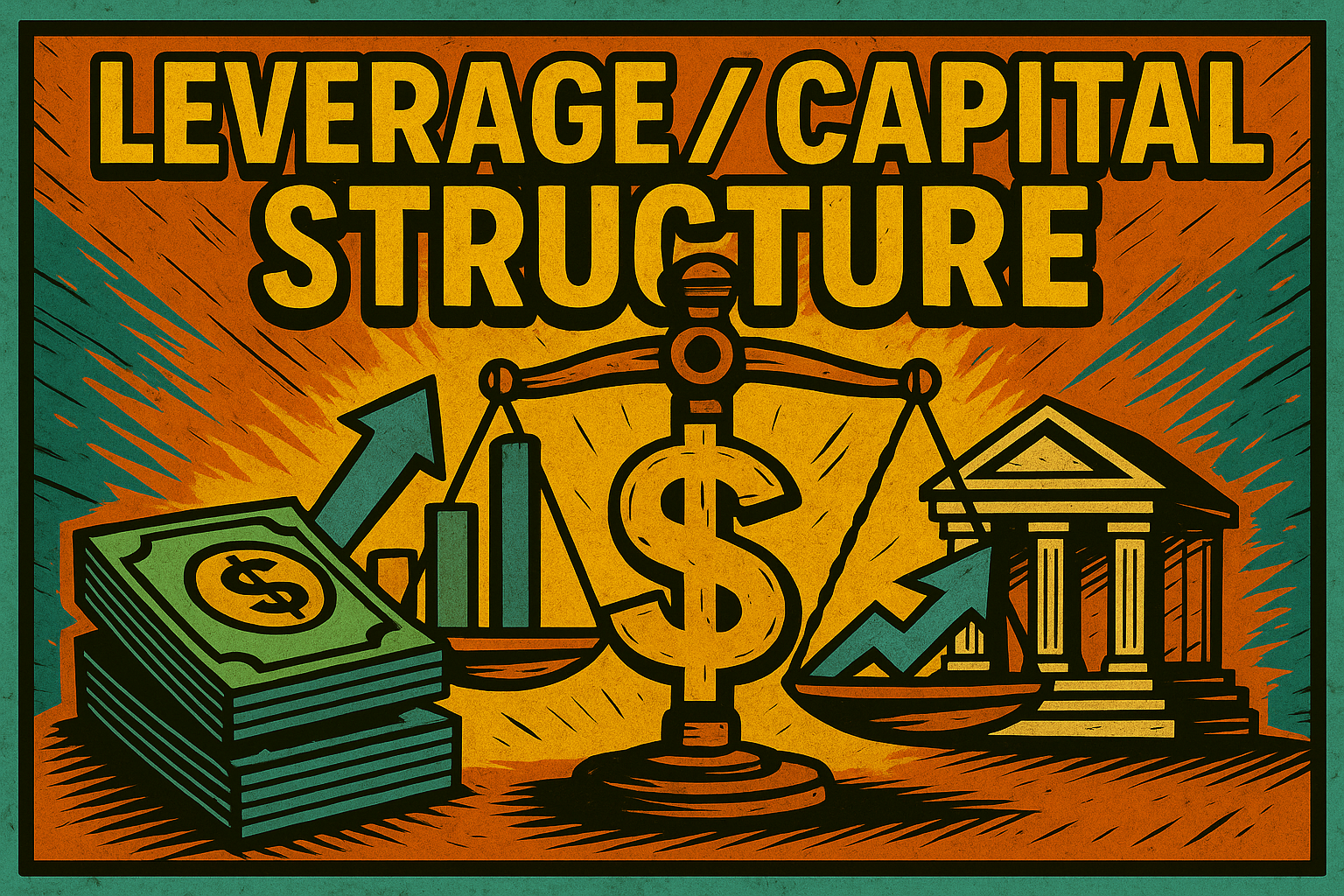Leverage/Capital Structure
“Debt talks loud, Equity talks long.”

Leverage / Capital Structure: Understanding How Your Business Is Funded
Is your business built on debt, equity, or a healthy mix of both?
Understanding your leverage and capital structure is crucial to managing financial health, planning for growth,
and staying attractive to lenders and investors.
What Is Capital Structure?
Your capital structure is the combination of debt (like loans and credit lines) and equity (like owner’s capital or investor funding) used to finance your business. It shows how your operations, assets, and expansion are being paid for—and at what level of financial risk.
A well-balanced capital structure:
- Supports sustainable growth
- Lowers financing costs
- Increases lender and investor confidence
Getting the mix right is critical—too much debt increases risk, too little can slow growth.
Understanding Leverage
Leverage is the use of debt to finance assets or expansion.
While using borrowed money can accelerate growth, it also increases financial obligations and increases the risk of financial strain if revenues decline or interest rates rise.
Simply put:
More debt = higher risk (and potentially higher reward)
Put another way:
- Smart leverage can fuel growth.
- Over-leverage can restrict cash flow and damage credit.
Why Understanding Capital Structure is Important & Useful
- Strategic Planning: Knowing your leverage helps you make smarter decisions about growth, investments, and financing.
- Bank Readiness: Banks assess leverage and capital structure metrics when you apply for loans or credit.
- Investor Confidence: Investors look for companies with balanced, responsible capital structures.
- Crisis Resilience: Businesses with manageable debt levels are better positioned to weather downturns.
What does a "HEALTHY" Capital Structure look like?
“What’s healthy for you might sink me”

...It Depends
There are a number of ways to look at this matter of Healthy Capital Strutures and there’s
a lot of truth to the old saying that “What flies in TECH tanks in TRUCKING”.
It depends on your industry, business model, and stage of growth.
Below are some relevant and meaningful ways to contemplate the matter.
What makes it "Healthy" is BALANCE
A healthy capital structure is all about balance.
the right mix of debt and equity that supports your business’s goals without overloading it with risk.
Why the Mix Matters
- Too much debt can lead to cash flow problems, high interest costs, and difficulty borrowing more.
- Too much equity can mean giving up control or diluting ownership—plus, equity can be a more expensive source of capital long-term.
A healthy structure gives you:
- Enough leverage to grow aggressively when needed
- Enough equity to keep you stable, credible, and resilient
- The flexibility to respond to economic changes or opportunities
What makes it "Healthy" is ALIGNMENT
A healthy capital structure is not just about ratios—it’s about fit:
- Is it aligned with your strategy (e.g., aggressive growth vs. steady income)?
- Is it sustainable under stress (can you weather a dip in revenue)?
- Does it give you access to more capital if needed?
“Healthy” means resilient, flexible, and growth-ready.
It's dependent on Business Stage
| Business Stage | Typical Capital Structure | Notes |
|---|---|---|
| Startup | Mostly equity, possibly founder loans or SBA financing | Lenders see early-stage debt as high-risk |
| Growth | Mix of equity and debt | Debt used to scale operations, fund expansion |
| Mature | Optimized mix, often higher leverage | Stable cash flow supports more debt comfortably |
| Distressed | Over-leveraged or equity-starved | May require restructuring, refinancing, or capital infusion |
Signs Your Capital Structure May Be Off-Balance
A business can look profitable on the surface, but if your capital structure is out of sync, it can quietly erode cash flow, stunt growth, and trigger lender or investor pushback. Here are the warning signs that your debt-equity mix might need a closer look:
💸 You’re constantly short on cash despite strong sales
What’s happening: You’re bringing in revenue, but not keeping enough liquid cash on hand.
What it means: You may be over-leveraged—your debt payments, interest, or reinvestment needs are consuming too much of your incoming cash. This leaves you tight on working capital and vulnerable to disruptions.
Red flag: Positive income on paper, but struggling to pay vendors or meet payroll.
💥 Debt payments strain daily operations
What’s happening: Loan payments or interest are eating into your operating cash, forcing tough choices (like delaying orders or deferring salaries).
What it means: You may have too much short-term or high-interest debt, or your cash flow isn’t strong enough to support your leverage. This puts daily operations—and morale—at risk.
Red flag: You’re managing the business around debt obligations, not for growth.
🏦 Lenders are tightening terms or rejecting applications
What’s happening: You apply for credit or refinancing, but banks say “not now” or demand stricter terms (higher rates, more collateral, shorter terms).
What it means: Your debt ratios may be signaling too much risk—high leverage, low DSCR, or insufficient equity cushion. This weakens your borrowing profile.
Red flag: You’ve become a “watch list” borrower even though your business is operating normally.
📉 Equity investors demand more control
What’s happening: Investors are asking for more board seats, voting power, or ownership percentage than you expected.
What it means: Your equity position is weak, making outside capital more expensive and power-shifting. Investors perceive risk or want to protect their upside.
Red flag: You’re sacrificing long-term control just to access short-term capital.
🚧 You can’t raise new capital without sacrificing too much
What’s happening: New lenders demand personal guarantees or steep terms. New investors want a big chunk of equity.
What it means: Your current capital structure doesn’t support expansion. Either you’re over-leveraged and banks see risk, or undercapitalized and equity becomes expensive.
Red flag: Capital comes with strings that weaken your strategic flexibility or ownership.
Bottom Line
These signs don’t always show up in your profit and loss statement—but they absolutely show up in cash flow, control, and confidence.
If any of these feel familiar, it’s time to:
- Reassess your leverage ratios
- Run a Capital Structure Health Check
- Consider rebalancing through refinancing, retained earnings, or strategic capital planning

How to Strengthen Your Capital Structure
Your capital structure doesn’t have to be static. You can shape it strategically to improve financial health, reduce risk, and set your business up for long-term success. Here’s how:
1. Reinvest Profits to Grow Equity
Instead of pulling all your profits out of the business, consider reinvesting a portion back in.
✅ Why it matters:
- Boosts retained earnings, strengthening your equity base
- Reduces your reliance on external funding
- Makes your balance sheet more attractive to lenders and investors
🧭 When to use:
- During periods of growth or when preparing for a financing round
- When you want to increase owner control without taking on more debt
2. Refinance Expensive Debt
Old or high-interest loans can drain cash flow and inflate your leverage ratios. Refinancing gives you breathing room.
✅ Why it matters:
- Lowers interest expense, improving your Interest Coverage Ratio
- Can extend repayment terms, reducing short-term pressure on cash
- May consolidate multiple debts into one manageable payment
🧭 When to use:
- Interest rates have dropped
- Your credit profile has improved
- You’re approaching a covenant threshold or liquidity squeeze
3. Improve Cash Flow to Boost DSCR
Lenders rely heavily on the Debt Service Coverage Ratio (DSCR) when deciding whether to extend credit. Improving cash flow directly improves this metric.
✅ Why it matters:
- Higher DSCR = more bankable and less risky
- Strengthens your ability to handle debt responsibly
- Creates buffer capacity for unexpected expenses or economic shifts
🛠 How to do it:
- Tighten accounts receivable
- Reduce unnecessary overhead
- Improve pricing and margins
- Lease vs. buy decisions to reduce capital expenditures
4. Consider Equity Funding for Expansion
If you’re eyeing rapid growth, big equipment purchases, or geographic expansion, consider bringing in equity investors rather than loading up on debt.
✅ Why it matters:
- Doesn’t require regular repayment like debt
- Strengthens your equity position, improving the Capitalization Ratio
- Can bring more than just capital—investors may offer expertise and connections
⚠️ Considerations:
- You may give up partial ownership or decision-making power
- Investors typically expect a return through dividends or exit strategies
Bottom Line
A strong capital structure is flexible, resilient, and ready to grow.
Don’t just track your debt and equity—manage them like tools. The right adjustments now can increase access to capital, reduce risk, and give your business room to thrive.

Final Thoughts: Leverage & Capital Structure
Your capital structure isn’t just a line on your balance sheet—it’s a reflection of your strategy, your resilience, and your readiness to grow.
Getting the right mix of debt and equity isn’t about hitting someone else’s target—it’s about building a structure that fits your business: your industry, your goals, your risk tolerance. Too much debt can choke cash flow and increase stress. Too little leverage, and you may miss opportunities that require capital to seize.
A “healthy” structure doesn’t mean being debt-free. It means being intentional—knowing what you owe, why you owe it, and how it fuels your business forward.
And most importantly: your capital structure is not set in stone. It evolves with your business. That’s why smart business leaders monitor it, manage it, and fine-tune it over time—just like any other part of the operation.
Control the capital, and you control the path forward.
Use the tools, run the numbers, and keep the conversation open—with your team, your banker, and your future investors. Your structure should support your vision—not hold it back.
💡 Bonus: Key Metrics (financial ratios) That Reveal Your Financial Position
Debt Ratio
- Definition: Total Debt / Total Assets
- Purpose: Shows what proportion of a company’s assets are financed by debt.
- Interpretation:
- 0.5 → more debt than assets: potentially risky.
- < 0.5 → more equity than debt: more conservative.
Note: High ratios may signal
over-dependence on borrowed money
Interest Coverage Ratio
- Definition: EBIT / Interest Expense
- Purpose: Measures how easily a company can pay interest on outstanding debt.
- Interpretation:
- < 1.5 → red flag, higher risk of default.
- 2–3 → comfortable coverage.
Note: A declining ICR trend may signal
rising debt burden or declining profits.
Debt Service Coverage Ratio (DSCR)
- Definition: Net Operating Income / Total Debt Service (Principal + Interest)
- Purpose: Assesses ability to cover all debt obligations.
- Benchmarks:
- < 1.0 → insufficient income to cover debt.
- ≥ 1.25 → often required by lenders.
Note: Lenders use this for loan underwriting
and covenant setting/testing.
Capitalization Ratio
- Definition: Long-term Debt / (Long-term Debt + Shareholder Equity)
- Purpose: Measures proportion of long-term debt in the overall capital structure.
- Interpretation:
- Higher = more leverage, more financial risk.
- Lower = stronger equity position.
Use Case Example: Assessing long-term
financial strategy and/or investor appeal.

